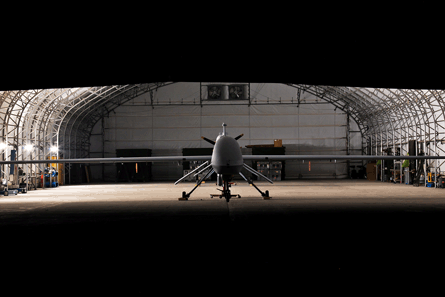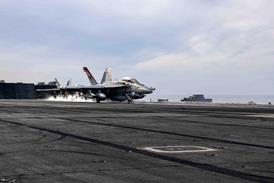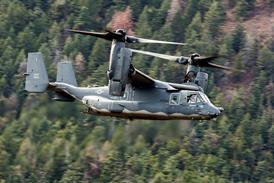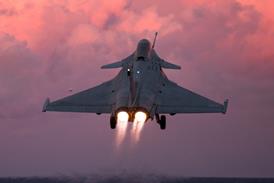Unmanned air vehicles can now be made to equip everyone from division headquarters to squad leaders, and as they have diffused through the ranks, ease of operation has become a priority. That means common parts and user-friendly displays.
Gasoline has ever been the traditional fuel of choice for unmanned air vehicles (UAVs) manufacturers. It is cheap and easy to find. Engines that burn gasoline are relatively simple and inexpensive to build.
Fuel, of course, comes from crude oil, but crude oil is not a uniform substance. It is made up of liquids of varying densities. Before crude oil can be used to make fuel, it needs to be separated by its different weights - or fractions.
 |
|---|
© US ArmyThe US Army's MQ-1C Gray Eagle runs on heavy fuel |
These fractions are separated in an atmospheric distillation unit. The lightest fractions of methane, ethane, propane and butane - gasses - are often burned, used as fuel for the refinery or piped to petrochemical plants. The next heaviest fraction is naphtha, which can be used as a blendstock in gasoline.
RELATIVELY LITTLE PROCESSING
The next fractions are the distillates, which includes kerosene and jet fuel. Unlike other fractions, jet fuel needs relatively little processing. Refineries simply remove impurities once the distillates are separated in an atmospheric distillation unit.
Like crude oil, jet fuel is not a uniform substance - it is a mixture of hydrocarbons of varying lengths. The lengths of those hydrocarbon molecules determine the properties of the jet fuel, such as the flash point, freezing point and maximum burning temperature. As a whole, jet fuel is known as heavy fuel because it is denser and contains more energy in a given volume than gasoline.
The density of heavy fuels is one of its major selling points. "If your airplane is limited in the volume of fuel you can carry with it - and not the weight of the fuel - then you can carry more energy in the tank with JP-8 [fuel blend] than you can with gasoline," says Andy Allen, chief technology officer at South Carolina-based engine designer XRDI. "That translates into greater range for the aircraft."
One inherent flaw in heavy fuel is that it takes more energy to break up than lighter liquids. However, this quality makes it a desirable fuel for places where safety is paramount.
 |
|---|
© General Atomics Aeronautical SystemsHeavy-fuel engines are in high demand for UAVs |
US military aircraft mostly fly on JP-8, but the US Navy has its own blend, JP-5, which has a higher flash point. Fuels with lower flash points are a danger on ships. The biggest appeal of heavy-fuel engines is their commonality with other military equipment. Virtually everything in the military runs on heavy fuels. Aircraft fly on JP-8 and Humvees run on diesel: heavy fuels that are safer to handle, and thus easier to move than gasoline.
For a robust supply chain set up to handle heavy fuels, lighter fuels can present a major headache.
"Getting it to the base is a huge consideration, because you either have to truck it in or fly it in - and people don't like to fly gasoline," says Ron Storm, director of military market development with UK-based engine builder Ricardo.
"Trucking it in is more expensive because you're bringing in a separate fuel. Now I have to truck in not one type of fuel but two types of fuels, and what happens if that truck gets blown up and my JP-5 truck is okay?"
AN EXOTIC FUEL
Thus, gasoline - though the standard for personal vehicles - is an exotic fuel in military environments.
Gasoline for military operations tends to be sourced locally, and is often contaminated or substandard - well below the standards of the converted lawnmower and chainsaw engines that power many UAVs, to say nothing of aviation-grade fuels.
"The fuels you get overseas [are] horrible," notes Storm. "If you're getting heavy gas you don't have to worry about getting fuel out of a Mountain Dew bottle on the side of the road. If somebody's pouring fuel into a Mountain Dew bottle, I doubt their master containment vessel is in much better condition."
As a result, heavy-fuel engines are in high demand for UAVs. Every new programme of record running on fossil fuels is required to accept heavy fuel. The signature American UAV, the General Atomics Predator, runs on gasoline, while its newer iterations, the MQ-9 Reaper and the Army's MQ-1C Gray Eagle both run on heavy fuel.
As the number of UAVs has mushroomed, so too has the need for engines. Before the invasions of Afghanistan and Iraq, heavy-fuel engines for smaller aircraft were very uncommon. Now, there are dozens of competitors.
Respected engine manufacturers such as Cosworth, Orbital, Ricardo and Gobler-Hirth are building families of small heavy fuel engines - and aggressively marketing to UAV manufacturers.
But the practicality of heavy-fuel engines finds its limit in downscaling.
A plethora of powerplant manufacturers are developing heavy-fuel engines as small as 3hp. But beyond that, utility becomes limited. "That's my equation of when you don't need an engine anymore - when the spark plug is bigger than the engine. Then you might as well go with a battery," says Storm.
Indeed, it is batteries and other alternative propulsion methods that are likely to replace fossil fuels as a UAV's primary power source - but they are being adapted so slowly that manufacturers have little to fear.
However, alternative power sources do not seem to a priority for weapons buyers. Certainly, the military take-up has been slow.
Batteries commonly used to power mini- and micro-UAVs simply cannot store enough power to make their weight worthwhile on a larger scale. But as research into alternative propulsion accelerates, energy storage devices like batteries are unlikely to remain so ineffective.
Other fuels represent another challenge to the heavy fuel industry, but the technical maturity levels are low enough that they are an unlikely competitor for the near future.
A US Special Operations Command programme for a high-altitude long endurance (HALE) technology testbed ended when the aircraft, AeroVironment's Global Observer, crashed during a flight. A similar, self-funded aircraft from Boeing, Phantom Eye, is yet to take to the air.
While falling budgets will take their toll, UAVs are solidly entrenched in the intelligence, surveillance and reconnaissance role, and are set to dramatically expand. Until a serious alternative power method comes along, or fuel simply becomes too expensive, heavy-fuel engine manufacturers can enjoy their place in the sun.
Source: Flight International























